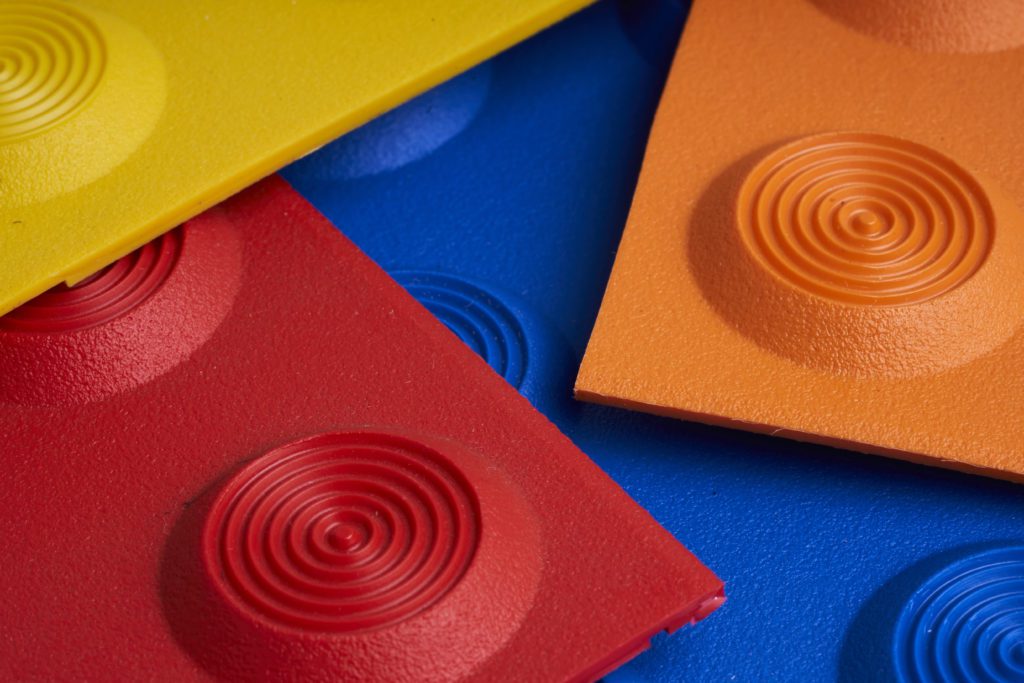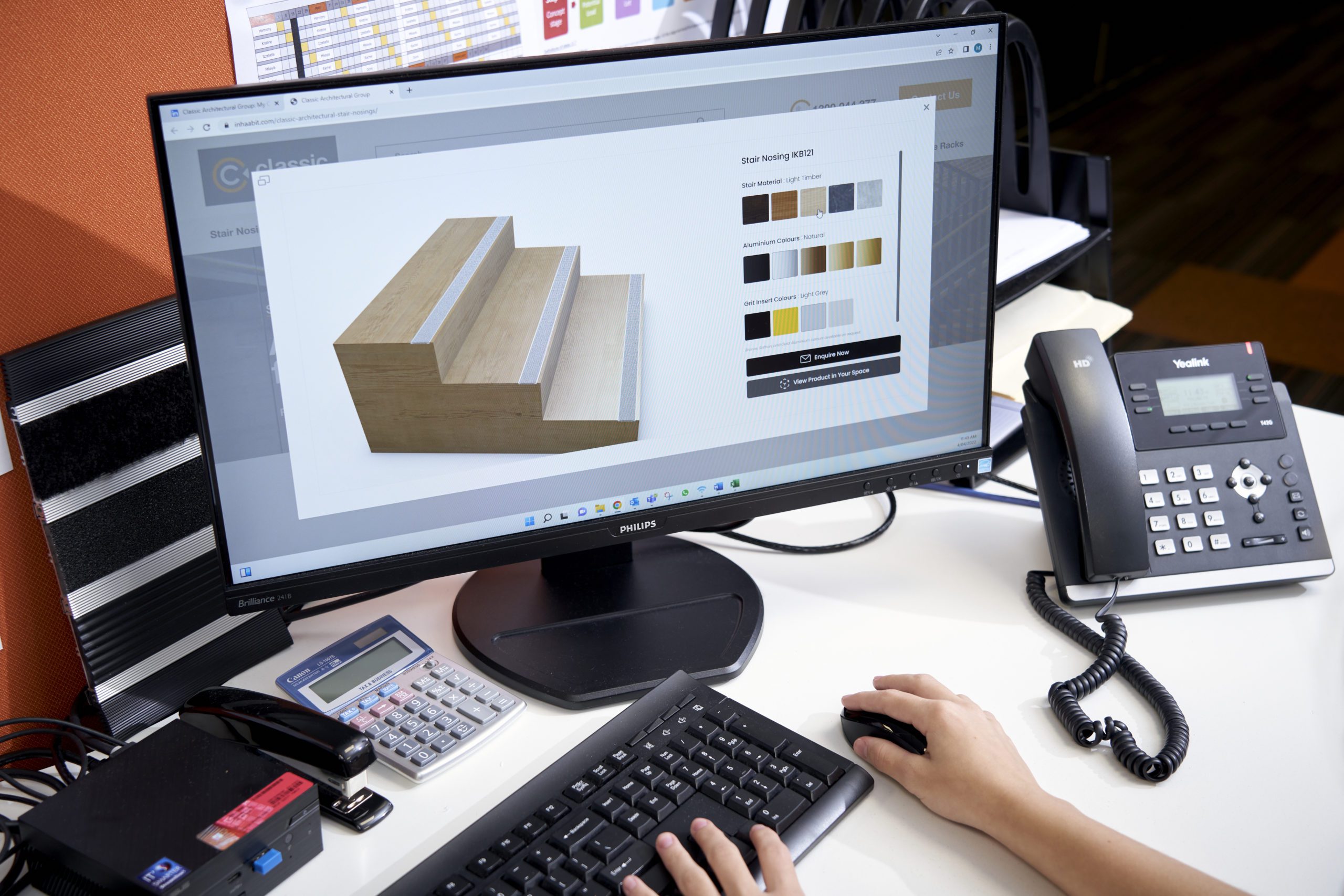Tactile ground surface indicators are a crucial floor safety feature for the visually impaired
Raised tactile features commonly installed on the ground, Tactile Ground Surface Indicators (TGSIs) are used to provide tactile cues that can be easily detected and interpreted. Tactile indicators are a crucial access feature that helps visually impaired individuals navigate their surroundings safely and confidently.
Often located at main entrances, pathways, and at the top and bottom of ramps and stairs, TGSIs are designed to provide directional cues and alert to impending hazards.
Available in various materials, colours, sizes and shapes to suit the application, tactiles are an essential floor safety requirement in all public areas with foot and wheeled access.
In this article, we’ll explore the two main types of tactile indicators available, their differences and relevant applications.
Directional Tactile Indicators
According to AS/NZS 1428.4, a directional tactile indicator is “an indicator used as a guide to a safe route indicating a direction of travel”.
Put simply, directional tactiles provide key orientational cues, guiding blind and vision-impaired pedestrians to safely access the best path of travel.
Types of directional tactile indicators
Comprising of directional bars, you’ll often find these in the form of integrated or discreet tactile designs. Choosing between the two types often depends on the environment, aesthetic considerations and the level of visibility required.
Integrated directional tactile indicators

Integrated tactiles come in the tactile tile format. Suitable for use in both indoor and outdoor settings, they often come in a pre-set plate design offering a defined pattern that is made of the same material and luminance as the base surface.
Depending on the material type, they can be retrofitted or embedded directly into the floor surface. Integrated directional tactiles can be more resistant to wear and tear or damage caused by foot traffic or other environmental factors.
Commonly used material types are polyurethane and ceramic, with ‘peel and stick’ type products making installation more cost-effective.
Discreet directional tactile indicators

Discreet tactiles are installed as individual tiles, allowing for custom dimensions.
Where directional TGSIs should be used
As outlined by AS/NZS 1428.4, directional TGSIs should be installed at:
- Mid-block crossings to indicate the location of crossings, tram or bus stops.
- Intersections that incorporate slip lane crossings to signify the location of the crossing and the direction of travel across the central island when the pathway does not directly cut through the island.
- At intersections where the distance between the point of entry to the road and the property line exceeds 3000 mm.
- In an open space that’s devoid of any other tactile cues, to provide guidance from point A to point B.
Warning (Hazard) Tactile Indicators
According to AS/NZS 1428.4, a warning tactile indicator is “an indicator that is used as a warning of a hazard and the need to stop, consider, investigate and wait before proceeding.”
Acting as a ‘stop’ sign, they warn visually-impaired pedestrians of potential hazards in their path of travel so that they can safely access the situation before moving forward.

Warning TGSIs are often used in combination with directional TGSIs to indicate a specific point has been reached, such as arriving at a bus stop, or to indicate a change of direction.
Types of warning (hazard) tactile indicators
Similar to directional tactile indicators, warning tactiles are available in integrated and discreet designs.
Integrated warning tactile indicators

With a raised profile enhancing their visibility, integrated warning tactile indicators come in a tile format and are typically integrated into the surface itself, such as the pavement or steps.
Depending on the material type, they can be retrofitted or embedded directly into the floor surface. Integrated warning tactiles can be more resistant to wear and tear or damage caused by foot traffic or other environmental factors.
Commonly used material types are polyurethane and ceramic, with ‘peel and stick’ type products making installation more cost-effective.
Discreet warning tactile indicators

Installed as individual raised studs, discreet warning tactile indicators come in a vast array of material types, including solid brass, stainless steel and polyurethane.
These indicators come with different tops, for example, grit inserts for anti-slip benefits, as well as different rear stud types, including options without a rear stud that are self-adhesive.
The design aesthetic, functional goals and budget all have a role to play in product selection.
Where warning (hazard) tactile indicators should be used
As outlined by AS/NZS 1428.4, warning TGSIs should be used to warn of impending hazards in situations such as the following:
- Areas where serious falls or other life-threatening hazards may occur, such as on railway platforms or wharves.
- Overhead hazards that protrude into the continuous accessible path of travel, such as underneath stairs where the underside might be unprotected.
- Suspended hazards that may obstruct a continuous accessible path of travel, such as a drinking fountain or a telephone booth.
- Vehicle hazards on roadways that are not separated from pedestrian areas by a change of grade, such as car park exits or vehicular driveways that may impede a continuous accessible path of travel.
Tactile indicators must meet luminance-contrast requirements as per Australian Standards
Both directional and warning (hazard) tactile indicators must undergo LRV and luminance contrast testing to ensure compliance with Australian Standards.

Defined in Standard 1428.1 as “the light reflected from one surface or component, compared to the light reflected from another surface or component”, luminance contrast assesses the difference in the light reflective properties of each colour.
As a general requirement, tactile indicators must achieve a specified luminance-contrast to the base surface:
- Integrated tactiles (tile) – Minimum contrast standard of 30%
- Discreet tactiles (individual) – Minimum contrast standard of 45% if one colour and 60% if two colours
Classic Architectural Group provides a free online calculator for assessing the luminance contrast value of a floor or stair substrate with a tactile indicator, stair nosing, or a product of your choice. The calculator will provide you with the luminance contrast values for dry and wet readings, as well as a pass or fail result. You can use our free LRV calculator to receive instant results via email.
To learn more about the importance of luminance contrast testing per Australian Standards, click here.
Choosing the right material tactile indicators

Once you’ve identified the type of tactile indicators you need, as well as your preferred installation format, you can then explore the different materials available.
Offering unique uses and benefits, you can opt for tactile indicators made from different materials, such as solid brass, stainless steel, aluminium, polyurethane, and ceramic.
Ensuring that your chosen tactiles will meet your project’s functional and aesthetic requirements, here’s an overview of the various materials available at Classic:
- Solid brass tactile indicators – A timeless and aesthetic option that’s also durable and resistant to corrosion, ideal for interior and exterior applications
- Stainless steel tactile indicators – A highly durable and low-maintenance choice that’s resistant to corrosion, ideal for interior and exterior environments
- Aluminium tactile indicators – A lightweight and affordable option that is easy to install, making them versatile across a wide range of applications
- Polyurethane tactile indicators – The ultimate solution for unique designs and layouts, available in a huge range of colours and UV resistant
- Ceramic tactile indicators – UV-stablised, these offer premium durability and high resistance to wear, making them suitable for high-traffic areas
Complying with all Australian Standards, you can use our ‘Visualise It’ 3D/AR Product Visualisation Tool to help you determine and visualise the most suitable tactile indicators for your project.
Classic offers both standard and custom-designed tactile indicators to achieve your project’s goals

Beyond ensuring compliance with the guidelines set out by the Australian Standards, it’s important to select and install the right type of tactile indicators to ensure their effectiveness in providing directional and warning cues for the visually impaired. From assessing the overall layout and design of the space to the estimated level of foot traffic and various aesthetic considerations, you’ll be able to confidently create an environment that offers better and equal access for all.
Aside from tactile indicators, Classic supplies an end-to-end range of industry-leading floor and safety products including stair nosings, entrance matting, car park safety, bike racks, skate deterrents, and floor trims and covers. Architecturally designed, there are many styles, materials, and colours to choose from, to achieve your design aesthetic and adhere to all relevant Australian Standards and building codes.
Your friendly experts, you can rely on us to recommend the best solutions for your needs, as well as provide manufacturing and installation services for a complete solution.
For a quick quote or tailored consultation to learn more about our range, please get in touch with us by calling 1300 244 377 or emailing us at info@classic-arch.com.


